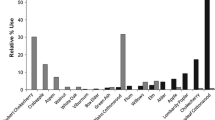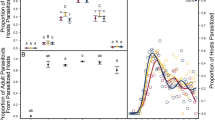Abstract
Foraging models are useful tools for generating predictions on predator–prey interactions, such as habitat or diet choice. However, the majority of studies attempting to explain adaptive behaviour using optimality criteria have assumed that there is no trait (e.g. size) variation among individual consumers or their prey. Hymenopteran parasitoids that attack the free-living stages of their host are an ideal system for studying the influence of body size on host selection because of the wide range of adult parasitoid sizes coupled with the defensive capabilities of their hosts. We report here our application of an experimentally parameterized host selection model to investigate the influence of parasitoid body size on the range of acceptable host instar classes. Using a demographic model, we compared the efficiency of parasitoids using an optimal host selection strategy against parasitoids using an indiscriminate host selection strategy over a range of different parasitoid body sizes. Net fitness accrual of parasitoids and the impact of host instar selection on aphid recruitment were assessed on different stage-structured aphid populations. Our results demonstrate that optimal host selection allows larger parasitoids to utilize a wider range of hosts. However, smaller parasitoids receive the greatest benefits from selecting hosts optimally by utilizing a restricted range of small, poorly defended hosts when they are abundant. We argue that the correlation between flexible host selection behaviour and adult body size may be a general phenomenon that applies to the majority of hymenopteran parasitoids that attack free-living, well-defended hosts. The potential of within-generation behavioural interactions to impact between-generation dynamics in host–parasitoid populations are discussed.





Similar content being viewed by others
References
Beckerman AP, Uriarte M, Schimitz OJ (1997) Experimental evidence for a behavioural-mediated trophic cascade in a terrestrial food chain. Proc Natl Acad Sci USA 94:1735–1738
Bolker B, Holyoak M, Krivan V, Rowe L, Schmitz O (2003) Connecting theoretical and empirical studies of trait-mediated interactions. Ecology 84:1101–1114
Charnov EL (1976a) Optimal foraging: attack strategy of a mantid. Am Nat 110:141–151
Charnov EL (1976b) Optimal foraging, marginal value theorem. Theor Popul Biol 9:129–136
Chau A, Mackauer M (2000) Host-instar selection in the aphid parasitoid Monoctonus paulensis (Hymenoptera: Braconidae, Aphidiinae): a preference for small pea aphids. Europ J Entomol 97:347–353
Chau A, Mackauer M (2001) Host-instar selection in the aphid parasitoid Monoctonus paulensis (Hymenoptera: Braconidae, Aphidiinae): assessing costs and benefits. Can Entomol 133:549–564
Colinet H, Salin C, Boivin G (2005) Host-age and fitness related traits in a koinobiont aphid parasitoid. Ecol Entomol 30:473–479
Comins HN, Hassell MP (1979) The dynamics of optimally foraging predators and parasitoids. J Anim Ecol 48:335–351
Dill LM (1987) Animal decision making and its ecological consequences: the future of aquatic ecology and behaviour. Can J Zool 65:803–811
Eijs IEM, van Alphen JJM (1999) Life history correlations: why are hymenopteran parasitoids an exception? Ecol Lett 2:27–35
Field J (1992) Guild structure in solitary spider-hunting wasps (Hymenoptera: Pompilidae) compared with null model predictions. Ecol Entomol 17:198–208
Fisher DO, Dickman CR (1993) Body size–prey relationships in insectivorous marsupials: tests of three hypotheses. Ecology 74:1871–1883
Fryxell JM, Lundberg P (1994) Diet choice and predator–prey dynamics. Evol Ecol 8:407–421
Gentry GL, Dyer LA (2002) On the conditional nature of neotropical caterpillar defenses against their enemies. Ecology 83:3108–3119
Gerling D, Roiberg BD, Mackauer M (1990) Instar-specific defense of the pea aphid, Acyrthosiphon pisum—influence on oviposition success of the parasite Aphelinus asychis. J Insect Behav 4:501–514
Gurney WSC, Nisbet RM (1985) Fluctuation periodicity, generation separation, and the expression of larval competition. Theor Popul Biol 28:150–180
Harvey JA, Harvey IF, Thompson DJ (1994) Flexible larval growth allows use of a range of host sizes by a parasitoid wasp. Ecology 75:1420–1428
Henry LM, Gillespie DR, Roitberg BD (2005) Does mother really know best? Oviposition preference reduces reproductive performance in the generalist parasitoid Aphidius ervi. Entomol Exp Appl 116:167–174
Henry LM, Roitberg BD, Gillespie DR (2006) Covariance of phenotypically plastic traits induces an adaptive shift in host selection behaviour. Proc R Soc B 273:2893–2899
Hivonen H, Ranta E (1996) Prey to predator ratio influences efficiency of larval Aeshna juncea dragonflies. Oecologia 106:407–415
Holling CS (1959) Some characteristics of simple types of predation and parasitism. Can Entomol 91:385–398
Karsai I, Somogyi K, Hardy ICW (2006) Body size, host choice and sex allocation in a spider-hunting pompilid wasp. Biol J Linn Soc 87:285–296
Kazmer DJ, Luck RF (1995) Field tests of the size-fitness relationship hypothesis in the egg parasitoid Trichogramma pretiosum. Ecology 76:412–415
Kouame KL, Mackauer M (1991) Influence of aphid size, age and behavior on host choice by the parasitoid wasp Ephedrus californicus—a test of host-size models. Oecologia 88:197–203
Krebs JR (1978) Optimal foraging: decision rules for predators. In: Krebs JR, Davies NB (eds) Behavioural ecology. Sinauer Associates, Sunderland, pp 23–63
Krebs JR, Ericksen JT, Weber MI, Charnov EL (1977) Optimal prey selection in the Great Tit (Parus major). Anim Behav 25:30–38
Kurczewski FE, Kurczewski EJ (1968) Host records for some North American Pompilidae (Hymenoptera) with a discussion of factors in prey selection. J Kansas Entomol Soc 41:1–33
Luttbeg B, Schmitz OJ (2000) Predator and prey models with flexible individual behavior and imperfect information. Am Nat 155:669–683
Ma BO, Abrams PA, Brassil CE (2003) Dynamic versus instantaneous models of diet choice. Am Nat 162:668–684
Mackauer M, Michaud JP, Volkl W (1996) Host choice by aphidiid parasitoids (Hymenoptera: Aphidiidae): host recognition, host quality, and host value. Can Entomol 128:959–980
Mangel M, Roitberg B (1992) Behavioral stabilization of parasite–host dynamics. Theor Popul Biol 42:308–320
Mittelbach GG (1981) Foraging efficiency and body size: a study of optimal diet and habitat use by bluegills. Ecology 62:1370–1386
Mondor EB, Roitberg BD (2000) Individual behaviour and population dynamics: lessons from aphid parasitoids. Entomol Exp Appl 97:75–81
Morris RJ, Fellowes MDE (2002) Learning and natal host influence host preference, handling time and sex allocation behaviour in a pupal parasitoid. Behav Ecol Sociobiol 51:386–393
Pachepsky E, Nisbet RM, Murdoch WW (2008) Between discrete and continuous: consumer-resource dynamics with synchronized reproduction. Ecology 89:280–288
Peacor SD, Werner EE (2001) The contribution of trait-mediated indirect effects to the net effects of a predator. Proc Natl Acad Sci USA 27:3904–3908
Persson L, De Roos AM (2003) Adaptive habitat use in size-structured populations: linking individual behavior to population processes. Ecology 84:1129–1139
Persson L, Greenberg LG (1990) Optimal foraging and habitat shift of perch (Perca fluviatilis) in a resource gradient. Ecology 71:1699–1713
Persson L, Leonardsson AM, De Roos AM, Gyllenberg M, Christensen B (1998) Ontogenetic scaling of foraging rates and the dynamics of a size-structered consumer resource model. Theor Popul Biol 54:270–293
Petchey OL, Beckerman AP, Riede JO, Warren PH (2008) Size, foraging, and food web structure. Proc Natl Acad Sci USA 105:4191–4196
Peterson G, Hardy ICW (1996) The importance of being large: parasitoid intruder-owner contests and their implications for clutch size. Anim Behav 51:1363–1373
Pyke GH, Pulliam HR, Charnov EL (1977) Optimal foraging: a selective review of theories and tests. Q Rev Biol 52:137–154
Roger C, Coderre D, Boivin G (2000) Differential prey utilization by the generalist predator Coleomegilla maculata lengi according to prey size and species. Entomol Exp Appl 94:3–13
Roitberg BD, Boivin G, Vet L (2001) Fitness, parasitoids and biological control: an opinion. Can Entomol 133:429–438
Sequeira R, Mackauer M (1992) Quantitative genetics of body size and development time in the parasitoid wasp Aphidius ervi (Hymenoptera, Aphidiidae). Can J Zool 70:1102–1108
Sequeira R, Mackauer M (1993) Seasonal variation in body size and offspring sex-ratio in field populations of the parasitoid wasp, Aphidius ervi (Hymenoptera, Aphiidae). Oikos 68:340–346
Sequeira R, Mackauer M (1994) Variation in selected life-history parameters of the parasitoid wasp, Aphidius ervi—influence of host developmental stage. Entomol Exp Appl 71:15–22
Stephens DW, Krebs JR (1986) Foraging theory. Oxford University Press, Oxford
Strohm E, Linsenmair KE (1997) Female size affects provisioning and sex allocation in a digger wasp. Anim Behav 54:23–34
Tsai JH, Wang JJ (2002) Host age choice for parasitism by Lysiphlebia mirzai and its effect on the development and reproduction of brown citrus aphid. Biocontrol 47:645–655
Vezina AF (1985) Empirical relationships between predator and prey size among terrestrial vertebrate predators. Oecologia 67:555–565
Visser ME (1994) The importance of being large: the relationship between parasitoid size and fitness in females of the parasitoid Aphereta minuta (Hymenoptera: Branconidae). J Anim Ecol 63:963–978
Wang XG, Messing RH (2004) Fitness consequences of body size-dependent host species selection in a generalist ectoparasitoid. Behav Ecol Sociobiol 56:513–522
Weisser WW (1994) Age-dependent foraging behavior and host-instar preference of the aphid parasitoid Lysiphlebus cardui. Entomol Exp Appl 70:1–10
Werner EE, Mittelbach GG, Hall DJ, Gilliam JF (1983) Experimental tests of optimal habitat use in fish: the role of relative habitat profitability. Ecology 64:1525–1539
Acknowledgments
We would like to thank the Roitberg lab, G. Baker, and E. Palsson for advice and support. Thanks go to J. Rosenheim and an anonymous reviewer for comments on a previous version of this manuscript. We would also like to acknowledge NSERC and the BC Greenhouse Growers for funding.
Author information
Authors and Affiliations
Corresponding author
Additional information
Communicated by Jay Rosenheim.
L. M. Henry and B. O. Ma contributed equally in the development of this manuscript.
Rights and permissions
About this article
Cite this article
Henry, L.M., Ma, B.O. & Roitberg, B.D. Size-mediated adaptive foraging: a host-selection strategy for insect parasitoids. Oecologia 161, 433–445 (2009). https://doi.org/10.1007/s00442-009-1381-2
Received:
Accepted:
Published:
Issue Date:
DOI: https://doi.org/10.1007/s00442-009-1381-2




